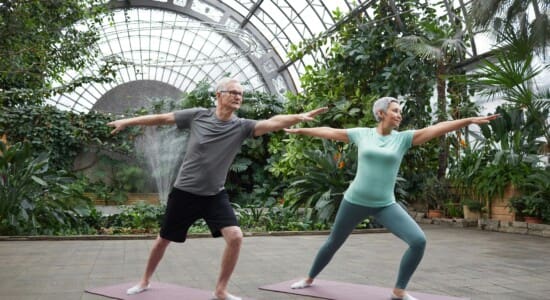
Losing muscle after 50 isn’t just a frustrating physical change—it’s a significant health risk. Muscle loss, also known as sarcopenia, is associated with decreased mobility, higher risk of falls, and metabolic decline. Fortunately, muscle loss after 50 is not a one-way street.
Emerging research shows that with the right interventions, muscle can be regained or maintained well into your senior years. In this post, we’ll break down the science of muscle loss, what really drives sarcopenia, and how to effectively reverse it using evidence-based strategies.
What Causes Muscle Loss After 50?
Muscle loss is not simply a byproduct of aging—it’s primarily driven by changes in lifestyle, hormonal shifts, and decreased physical activity. Understanding the underlying causes is essential to implementing effective solutions.
1. Decreased Muscle Protein Synthesis
With age, the body’s ability to build and repair muscle tissue decreases. This phenomenon is partly due to a reduction in anabolic hormones like testosterone and growth hormone (1).
2. Reduced Physical Activity
One of the primary drivers of sarcopenia is reduced muscle activation. As people age, they tend to move less, which leads to muscle atrophy (2).
3. Inflammation and Oxidative Stress
Chronic low-grade inflammation increases with age, promoting muscle breakdown and impairing muscle protein synthesis (3).
4. Neuromuscular Changes
Aging affects motor neurons, leading to decreased muscle activation and impaired coordination, which further accelerates muscle loss (4).
💡 Takeaway: Muscle loss is driven by hormonal changes, reduced activity, inflammation, and neuromuscular decline. Understanding these factors helps target solutions effectively.
Can Muscle Loss Really Be Reversed?
Yes—research supports that muscle loss after 50 can be significantly reduced or even reversed with the right combination of interventions. The key is addressing the root causes rather than just the symptoms.
1. Resistance Training: The Gold Standard
Strength training remains the most effective way to reverse muscle loss. It directly stimulates muscle protein synthesis, combats atrophy, and improves neuromuscular function.
- Frequency: Aim for 2-4 strength training sessions per week targeting major muscle groups (5).
- Intensity: Use progressive overload to continually challenge your muscles.
- Exercise Selection: Compound movements (like squats, deadlifts, and rows) are more effective for overall muscle maintenance and growth.
💡 Research Insight: A study from the International Journal of Environmental Research and Public Health (2022) found that resistance training significantly increased muscle size in older adults. Specifically, one study mentioned within the meta-analysis reported a muscle size increase of 6% after 12 weeks of resistance training (6).
2. High-Quality Protein Intake
Older adults often experience anabolic resistance, meaning the muscle’s response to protein intake becomes less efficient. This requires higher protein consumption to stimulate muscle growth.
- Protein Distribution: Spread protein intake evenly across meals to optimize synthesis (7).
- Leucine-Rich Sources: Foods like eggs, dairy, and whey protein are high in leucine, a key amino acid for muscle building.
- Protein Supplementation: Using whey or casein protein can help meet daily targets, particularly around workouts.
💡 Research Insight: Studies show that consuming 30 grams of high-quality protein per meal can effectively stimulate muscle protein synthesis in older adults (8).
3. Addressing Hormonal Decline
Decreased levels of testosterone and growth hormone can impair muscle maintenance. While natural interventions are often the first line of defense, some individuals may consider medical interventions under a physician’s care.
- Strength Training Boosts Hormones: Resistance exercise naturally increases testosterone and growth hormone levels, particularly when lifting heavy (9).
- Nutrition Matters: Adequate dietary fats and protein intake also support hormone production.
- Sleep and Recovery: Poor sleep can lower testosterone, so aim for 7-9 hours per night.
💡 Research Insight: Resistance training may help maintain or modestly increase testosterone levels in older men, especially when performed at higher intensities (10).
4. Inflammation and Recovery Strategies
Chronic inflammation can accelerate muscle breakdown. Anti-inflammatory strategies can help reduce muscle degradation and support recovery.
- Anti-Inflammatory Diet: Include foods rich in omega-3 fatty acids, such as salmon and walnuts.
- Sleep Hygiene: Quality sleep is critical for lowering inflammation.
- Active Recovery: Gentle activities like walking or cycling help reduce inflammation without overloading muscles.
💡 Research Insight: A meta-analysis published in the Journal of the International Society of Sports Nutrition found that higher omega-3 intake significantly reduced markers of inflammation and supported muscle recovery, aiding in muscle retention (11).
Want a clear, effective path to sustainable fat loss?
Sign up for the PlateauBreaker™ Plan and start your fat-loss journey today.
✏︎ The Bottom Line
Muscle loss after 50 isn’t inevitable—it’s a challenge that requires a strategic approach. By combining resistance training, adequate protein intake, hormonal support, and inflammation management, you can actively reverse muscle loss and build back strength. Don’t settle for decline—take charge of your muscle health and maintain resilience well into your later years.
👉 Looking for a complete strategy to optimize fat loss and muscle retention? Download my free eBook, “10 Weight Loss Myths That Are Keeping You Stuck—And How to Break Free,” and get started on the right path today!
Download our free eBook
10 Weight Loss Myths That Are Keeping You Stuck – And How to Break Free
Bibliography
(1) Faulkner, John A et al. “Age-related changes in the structure and function of skeletal muscles.” Clinical and experimental pharmacology & physiology vol. 34,11 (2007): 1091-6. doi:10.1111/j.1440-1681.2007.04752.x. https://pubmed.ncbi.nlm.nih.gov/17880359/
(2) Hämäläinen, Onni et al. “Low physical activity is a risk factor for sarcopenia: a cross-sectional analysis of two exercise trials on community-dwelling older adults.” BMC geriatrics vol. 24,1 212. 29 Feb. 2024, doi:10.1186/s12877-024-04764-1. https://pubmed.ncbi.nlm.nih.gov/38424514/
(3) Walston, Jeremy D. “Sarcopenia in older adults.” Current opinion in rheumatology vol. 24,6 (2012): 623-7. doi:10.1097/BOR.0b013e328358d59b. https://pubmed.ncbi.nlm.nih.gov/22955023/
(4) McNeil, Chris J, and Charles L Rice. “Neuromuscular adaptations to healthy aging.” Applied physiology, nutrition, and metabolism = Physiologie appliquee, nutrition et metabolisme vol. 43,11 (2018): 1158-1165. doi:10.1139/apnm-2018-0327. https://pubmed.ncbi.nlm.nih.gov/29986151/
(5) Schoenfeld, Brad J et al. “Effects of Resistance Training Frequency on Measures of Muscle Hypertrophy: A Systematic Review and Meta-Analysis.” Sports medicine (Auckland, N.Z.) vol. 46,11 (2016): 1689-1697. doi:10.1007/s40279-016-0543-8. https://pubmed.ncbi.nlm.nih.gov/27102172/
(6) Grgic, Jozo. “Use It or Lose It? A Meta-Analysis on the Effects of Resistance Training Cessation (Detraining) on Muscle Size in Older Adults.” International journal of environmental research and public healthvol. 19,21 14048. 28 Oct. 2022, doi:10.3390/ijerph192114048. https://pmc.ncbi.nlm.nih.gov/articles/PMC9657634/
(7) Agergaard, Jakob et al. “Even or skewed dietary protein distribution is reflected in the whole-body protein net-balance in healthy older adults: A randomized controlled trial.” Clinical nutrition (Edinburgh, Scotland) vol. 42,6 (2023): 899-908. doi:10.1016/j.clnu.2023.04.004. https://pubmed.ncbi.nlm.nih.gov/37086618/
(8) Deutz, Nicolaas E. P., et al. “Protein Intake and Exercise for Optimal Muscle Function with Aging: Recommendations from the ESPEN Expert Group.” Clinical Nutrition, vol. 33, no. 6, 2014, pp. 929-936. doi:10.1016/j.clnu.2014.04.007. https://pmc.ncbi.nlm.nih.gov/articles/PMC4208946
(9) Sattler, F., et al. “Testosterone and Growth Hormone Improve Body Composition and Muscle Performance in Older Men.” The Journal of Clinical Endocrinology and Metabolism, vol. 94, no. 6, 2009, pp. 1991-2001. https://pubmed.ncbi.nlm.nih.gov/19293261/.
(10) Resistance training may help maintain or modestly increase testosterone levels in older men, especially when performed at higher intensities (Hayes and Elliott, 2019). https://pubmed.ncbi.nlm.nih.gov/30692929
(11) Murphy, C., et al. “Effects of Omega-3 Polyunsaturated Fatty Acid Supplementation on Muscle Soreness After Exercise: A Systematic Review and Meta-Analysis.” Journal of the International Society of Sports Nutrition, vol. 17, no. 1, 2020, pp. 1-16. https://jissn.biomedcentral.com/articles/10.1186/s12970-020-00405-1



